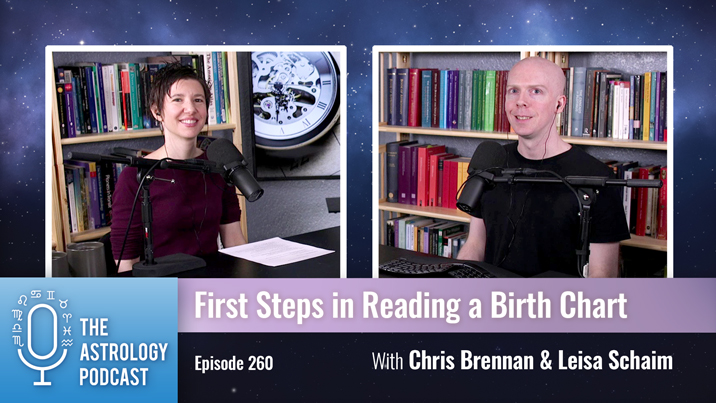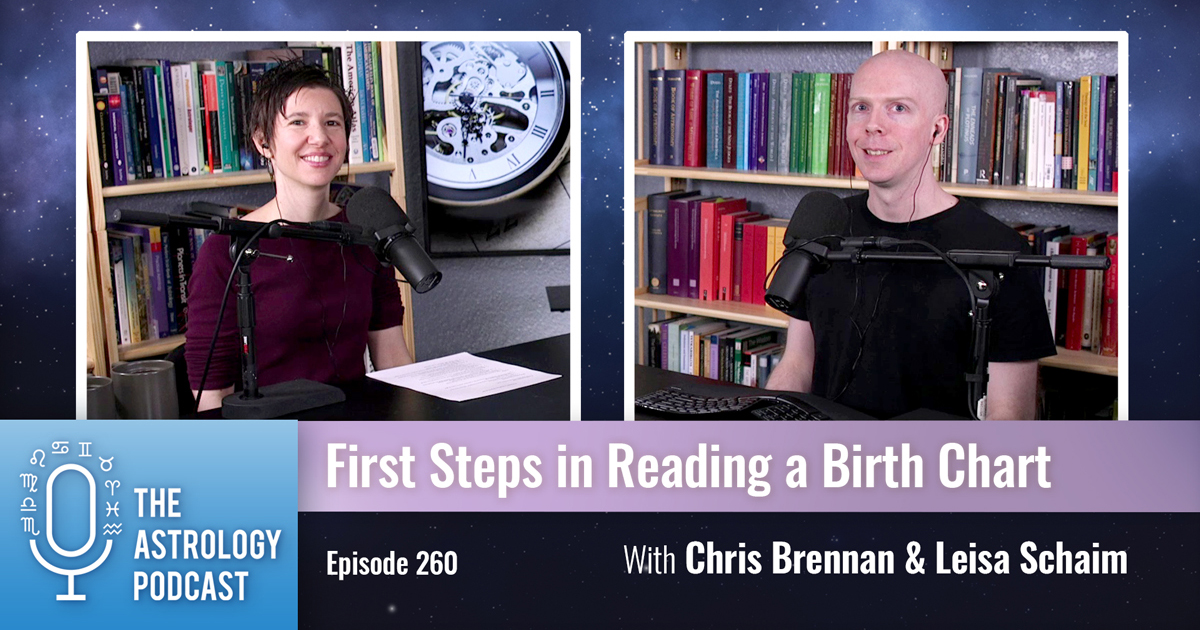
In episode 260 astrologers Leisa Schaim and Chris Brennan discuss the first steps you should take when trying to interpret a birth chart, and which astrological factors you should focus on in natal astrology.
New students of astrology often learn a number of different techniques, but they are often unsure of the order and priority that you should give to different factors when you are first looking at a new chart.
Since there are many different approaches to astrology, astrologers will tend to develop different approaches or prioritize different things, and this became clear in a thread we started on Twitter in preparation for this episode.
Our goal with this episode was to outline our approach to what we prioritize when looking at a new chart, although many of these factors are generally consistent with most major traditions of western astrology.
See the show notes below for a full breakdown of the steps that we recommend.
This episode is available in both audio and video versions at the bottom of this page.
News and Announcements
The Astrological Association of Great Britain is hosting an online astrology conference this week, June 26-28, 2020!
The title of the conference is Serving The Future, and it will feature 6 workshops, 4 plenaries, and five tracks with speakers from around the world.
You can sign up to attend the conference live or purchase the recordings on the Astrological Association’s website.
Show Notes
Here are some of the topics we discussed, with links to related resources:
Preliminary Remarks
- What is the first thing you look at when you pull up a new birth chart?
- What are the main things you should look at in every chart?
- One of the things I realized from the responses was it depends what you are looking for.
- What is the context?
- What information are you seeking to find?
- What is purpose of particular consultation?
- What draws your eye?
- Having a set system versus every chart presenting something unique.
- What techniques speak to the chart as a whole in some way?
- Or what placements will indicate overriding themes in the person’s life?
- Some techniques are tradition specific.
-
- First steps then depend highly on what the trad you follow emphasizes
-
Our steps on what to prioritize:
- Rising sign/Ascendant
- Subnote: the birth time, whether it looks rounded
- Ruler of the Ascendant: house, sign, aspects
- Sect – day or night chart
- Sun: sign, house, aspects
- Moon: sign, house, aspects
- Most positive benefic based on sect (Jupiter by day, Venus by night)
- Most negative planet based sect (Mars by day, Saturn at night)
- Stationary planets (within about a week before/after birth)
- Notable chart patterns: a stellium, T-square, etc.
- Planets conjunct the degrees of angles, and angular planets by sign
- Elemental or modality emphasis
- Close aspects, applying aspects, hard aspects
- Topics of consultation:
- General significator planet, house, and house ruler
Timing:
-
- Annual profections
- What is the profected house for the year?
- What is the ruler of the year?
- Transits involving that house or ruler
- Transits
- Slow moving transits currently happening
- What houses are Saturn and Jupiter transiting through
- Proximity to Saturn return or other Saturn angles
- Close outer planet transits
- Recent retrogrades
- Houses recent eclipses fall in
- Glance at progressions
- Any recent planetary stations
- Proximity to new or full moon
- Zodiacal Releasing: Spirit, Eros
- Annual profections
Timestamps
Here are some timestamps for topics covered at different points in the episode:
00:00:00 Intro
00:06:55 Looking at what stands out
00:09:26 Tradition-specific approaches
00:11:50 Sun, moon, rising
00:12:50 Birth time and ascendant degree
00:16:20 Day or night chart
00:17:25 Sun and moon locations
00:19:00 Ruler of ascendant
00:23:53 Houses ruled by sun and moon
00:24:40 Planets in first house
00:27:07 Analyzing the big three
00:29:56 Moon and emotions
00:36:09 Positive and challenging planets
00:46:28 Judy Blume’s chart
00:52:47 Stationary planets
00:57:09 Chart patterns
01:01:14 Planets conjunct degree of the angles
01:07:00 Elements and modalities
01:11:49 Close and hard aspects
01:13:39 Summary
01:17:02 Chart example Scorpio rising
01:22:08 Chart topics
01:25:50 Chart example Taurus rising
01:33:35 Chart example Virgo rising
01:39:45 Timing techniques
01:40:22 Annual profections
01:42:42 Transits
01:44:22 Saturn and life stage transits
01:46:42 Eclipses
01:49:03 Secondary progressions
01:51:12 Zodiacal releasing
01:53:46 Context importance
02:00:00 Final remarks
Watch the Video Version of This Episode
Here is the video version of this episode on how to read a birth chart:
–
Transcript
A full transcript of this episode is available: Episode 260 transcript
Listen to the Audio Version of This Episode
You can either play the audio version of this episode of the podcast directly from the website or download it as an MP3 to your device by using the buttons below:
Podcast: Play in new window | Download (Duration: 2:04:15 — 85.4MB)
